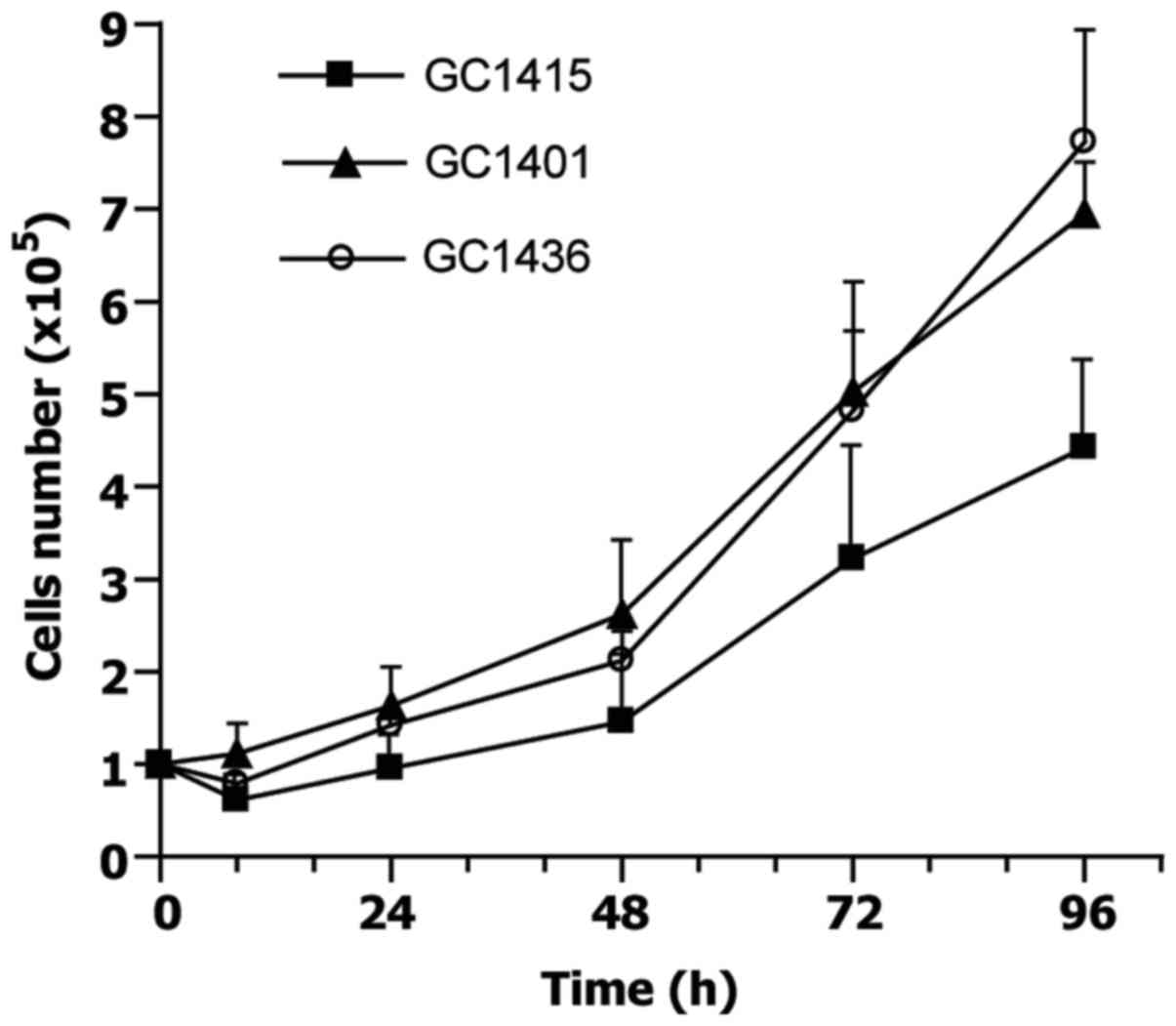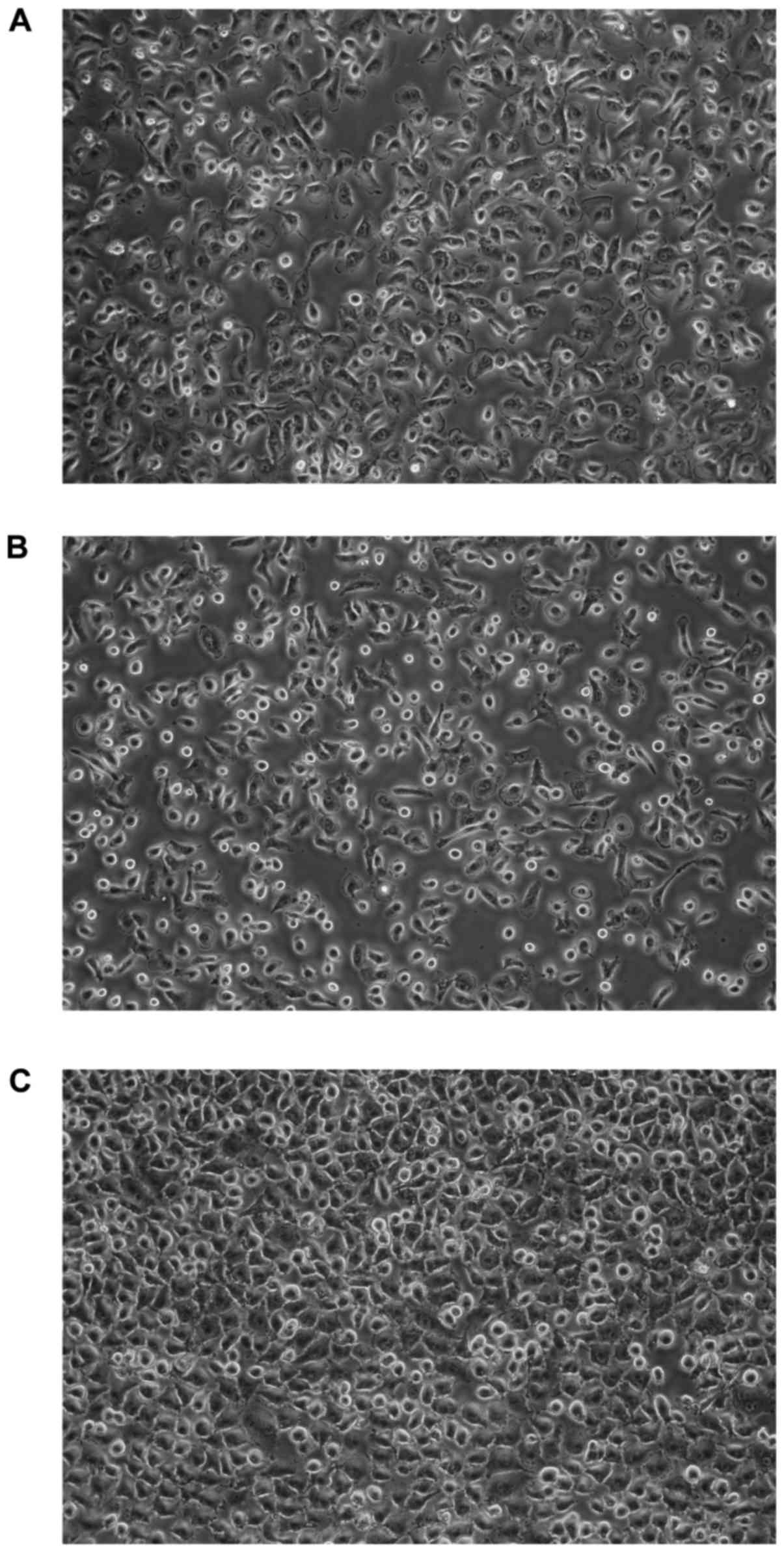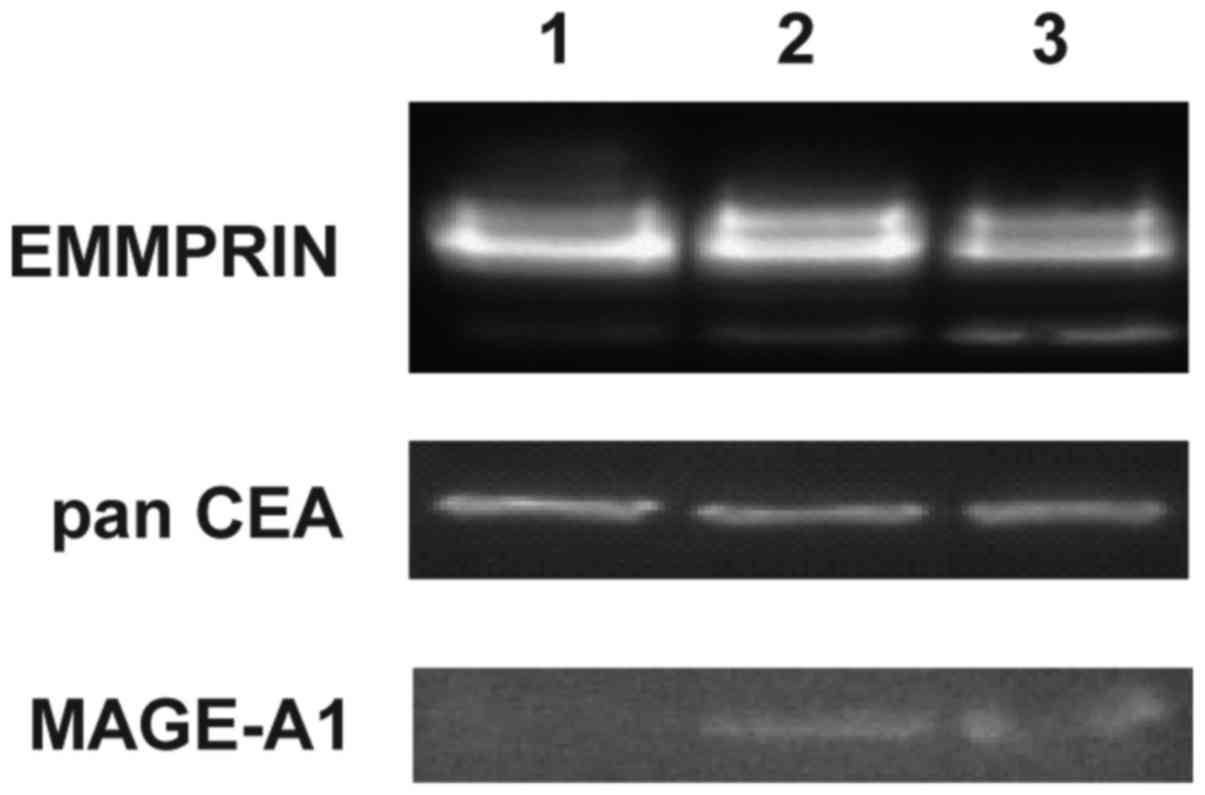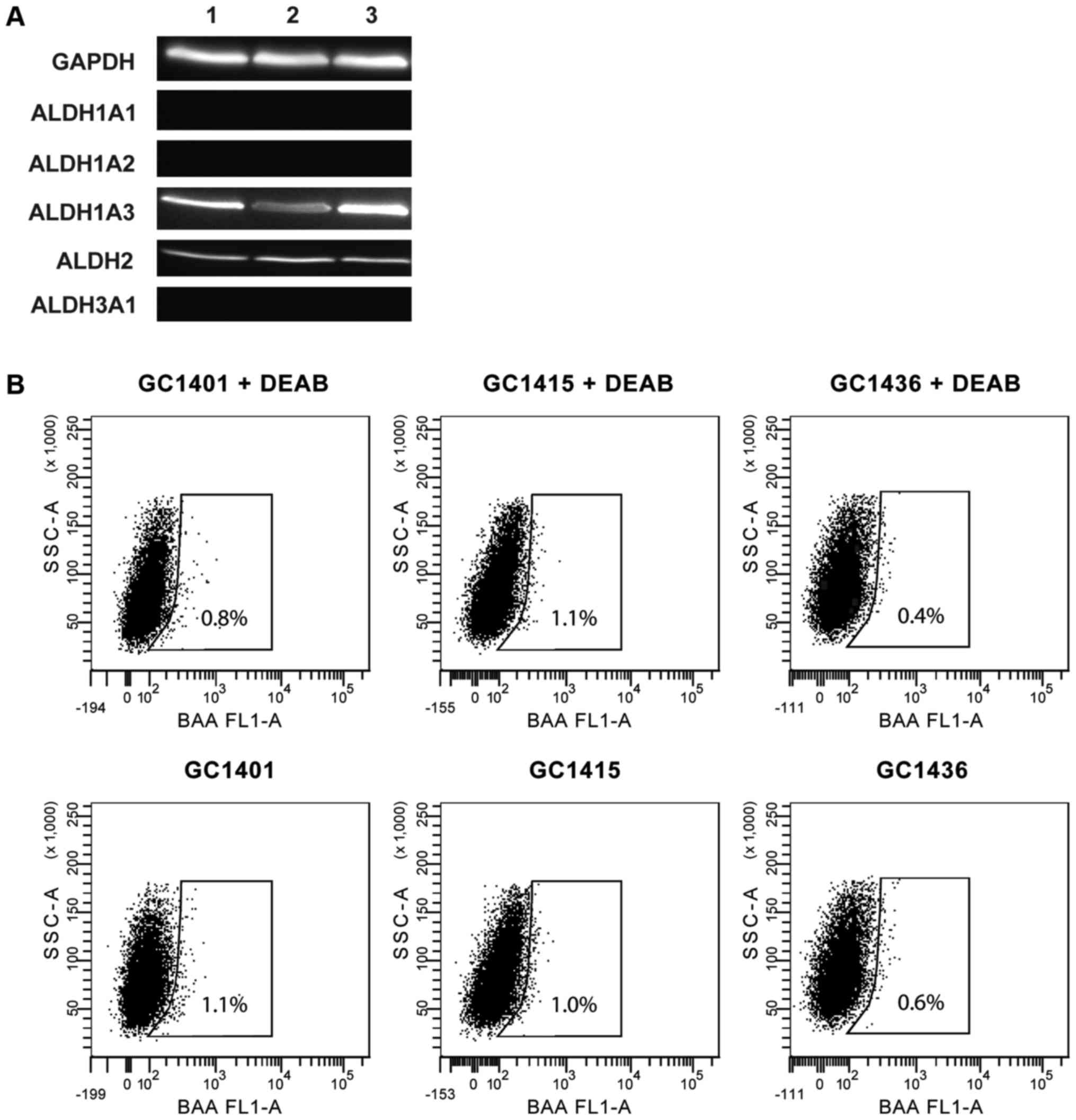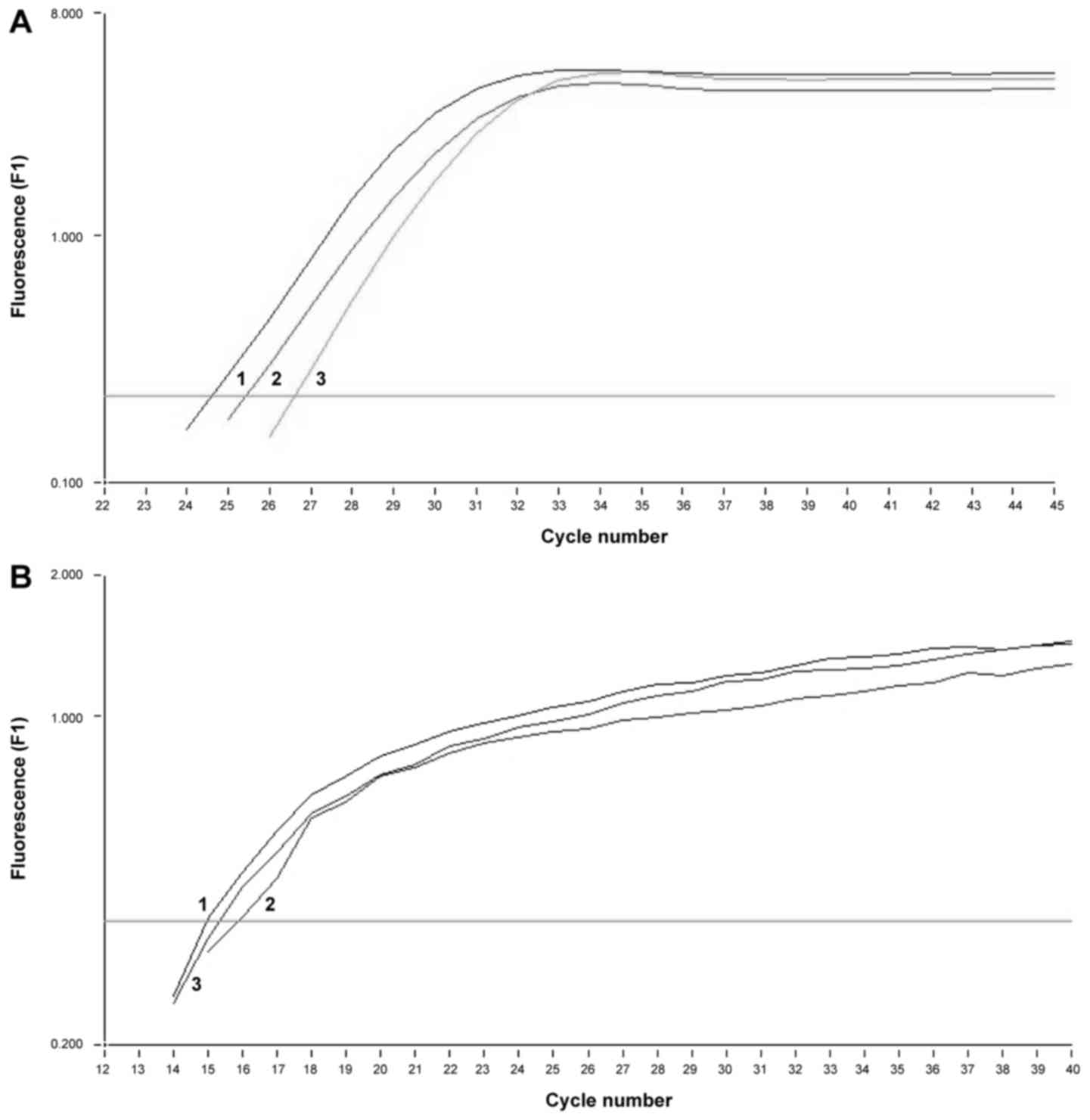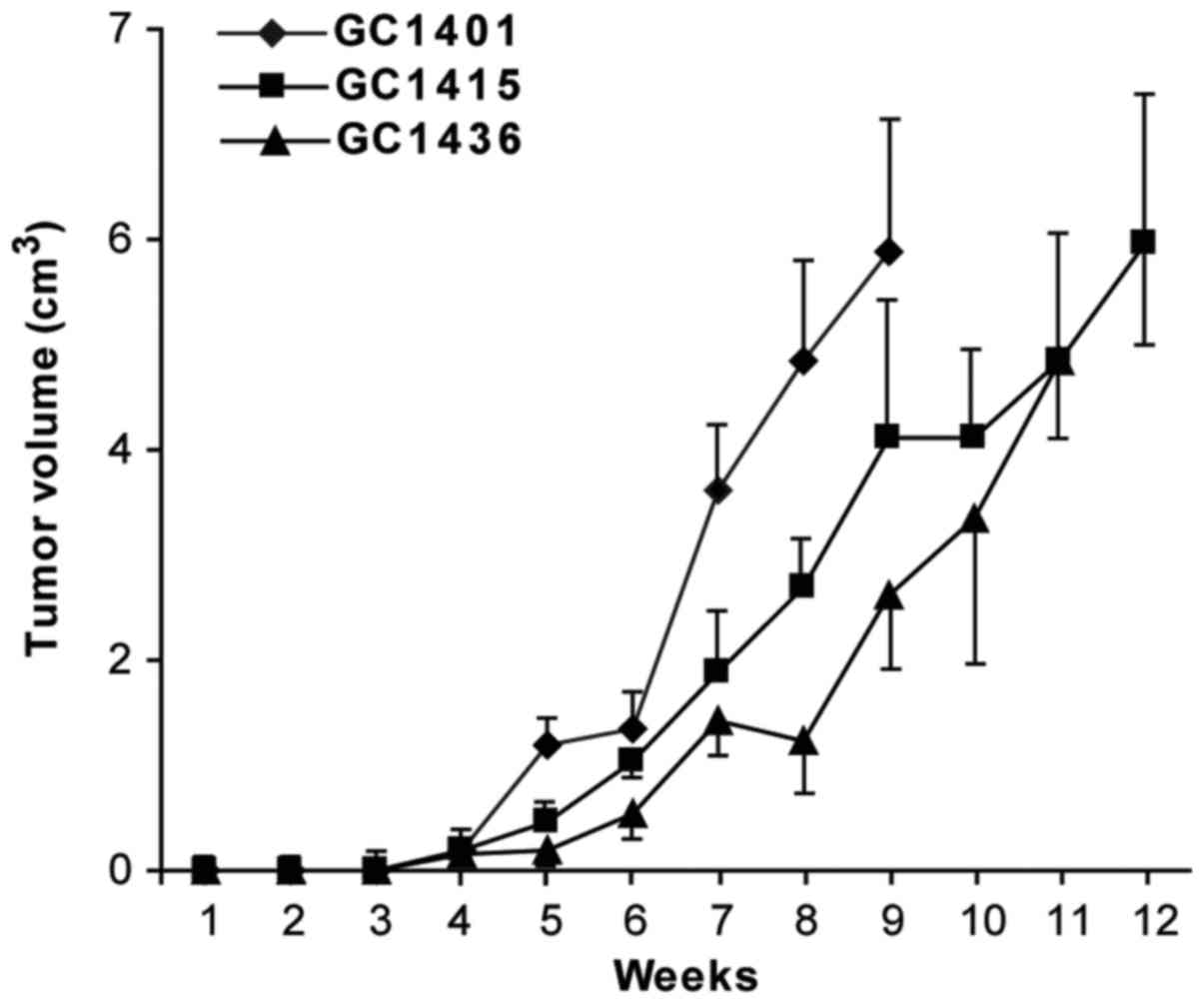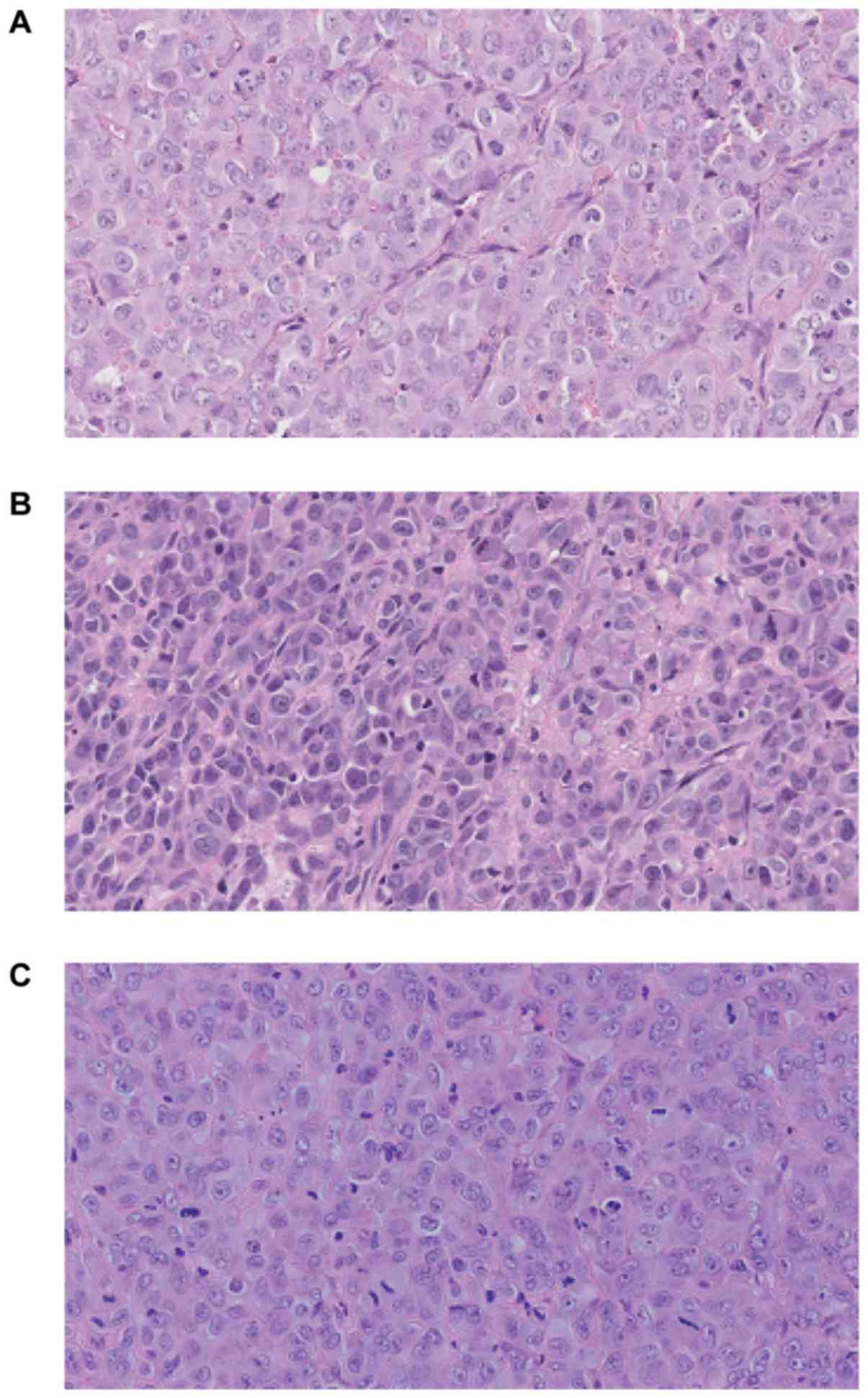|
1
|
Torre LA, Bray F, Siegel RL, Ferlay J,
Lortet-Tieulent J and Jemal A: Global cancer statistics, 2012. CA
Cancer J Clin. 65:87–108. 2015. View Article : Google Scholar : PubMed/NCBI
|
|
2
|
Verdecchia A, Santaquilani M and Sant M:
Survival for cancer patients in Europe. Ann Ist Super Sanita.
45:315–324. 2009.PubMed/NCBI
|
|
3
|
Fidler IJ: Biological heterogeneity of
cancer: Implication to therapy. Hum Vaccines Immunother.
8:1141–1142. 2012. View
Article : Google Scholar
|
|
4
|
Kato M, Shimada Y, Tanaka H, Hosotani R,
Ohshio G, Ishizaki K and Imamura M: Characterization of six cell
lines established from human pancreatic adenocarcinomas. Cancer.
85:832–840. 1999. View Article : Google Scholar : PubMed/NCBI
|
|
5
|
Park JG, Frucht H, LaRocca RV, Bliss DP
Jr, Kurita Y, Chen TR, Henslee JG, Trepel JB, Jensen RT, Johnson
BE, et al: Characteristics of cell lines established from human
gastric carcinoma. Cancer Res. 50:2773–2780. 1990.PubMed/NCBI
|
|
6
|
Chun YH, Kil JI, Suh YS, Kim SH, Kim H and
Park SH: Characterization of chromosomal aberrations in human
gastric carcinoma cell lines using chromosome painting. Cancer
Genet Cytogenet. 119:18–25. 2000. View Article : Google Scholar : PubMed/NCBI
|
|
7
|
Croker AK, Goodale D, Chu J, Postenka C,
Hedley BD, Hess DA and Allan AL: High aldehyde dehydrogenase and
expression of cancer stem cell markers selects for breast cancer
cells with enhanced malignant and metastatic ability. J Cell Mol
Med. 13:2236–2252. 2009. View Article : Google Scholar : PubMed/NCBI
|
|
8
|
Liao J, Qian F, Tchabo N,
Mhawech-Fauceglia P, Beck A, Qian Z, Wang X, Huss WJ, Lele SB,
Morrison CD and Odunsi K: Ovarian cancer spheroid cells with stem
cell-like properties contribute to tumor generation, metastasis and
chemotherapy resistance through hypoxia-resistant metabolism. PLoS
One. 9:e849412014. View Article : Google Scholar : PubMed/NCBI
|
|
9
|
Mu X, Patel S, Mektepbayeva D, Mahjoub A,
Huard J and Weiss K: Retinal targets ALDH positive cancer stem cell
and alters the phenotype of highly metastatic osteosarcoma cells.
Sarcoma. 2015:7849542015. View Article : Google Scholar : PubMed/NCBI
|
|
10
|
Ajani JA, Wang X, Song S, Suzuki A, Taketa
T, Sudo K, Wadhwa R, Hofstetter WL, Komaki R, Maru DM, et al:
ALDH-1 expression levels predict response or resistance to
preoperative chemoradiation in resectable esophageal cancer
patients. Mol Oncol. 8:142–149. 2014. View Article : Google Scholar : PubMed/NCBI
|
|
11
|
Li XS, Xu Q, Fu XY and Luo WS: ALDH1A1
overexpression is associated with the progression and prognosis in
gastric cancer. BMC Cancer. 14:7052014. View Article : Google Scholar : PubMed/NCBI
|
|
12
|
Schafer LG, McGowan-Jordan J and Schmid M:
ISCN 2013 An International System for Human Cytogenetic
Nomenclature. S. Karger; Basel: 2013
|
|
13
|
Szatanek R, Drabik G, Baran J,
Kolodziejczyk P, Kulig J, Stachura J and Zembala M: Detection of
isolated tumor cells in the blood and bone marrow of patients with
gastric cancer by combined sorting, isolation and determination of
MAGE-1, −2 mRNA expression. Oncol Rep. 19:1055–1060.
2008.PubMed/NCBI
|
|
14
|
Iwanuma Y, Chen FA, Egilmez NK, Takita H
and Bankert RB: Antitumor immune response of human peripheral blood
lymphocytes coengrafted with tumor into severe combined
immunodeficient mice. Cancer Res. 57:2937–2942. 1997.PubMed/NCBI
|
|
15
|
Alama A, Barbieri F, Favre A, Cagnoli M,
Noviello E, Pedullà F, Viale M, Foglia G and Ragni N: Establishment
and characterization of three new cell lines derived from the
ascites of human ovarian carcinomas. Gynecol Oncol. 62:82–88. 1996.
View Article : Google Scholar : PubMed/NCBI
|
|
16
|
Birsoy K, Possemato R, Lorbeer FK,
Bayraktar EC, Thiru P, Yucel B, Wang T, Chen WW, Clish CB and
Sabatini DM: Metabolic determinants of cancer cell sensitivity to
glucose limitation and biguanides. Nature. 508:108–112. 2014.
View Article : Google Scholar : PubMed/NCBI
|
|
17
|
Doak SH: Aneuploidy in upper
gastro-intestinal tract cancers-a potential prognostic marker?
Mutat Res. 651:93–104. 2008. View Article : Google Scholar : PubMed/NCBI
|
|
18
|
Leal MF, Martins do Nascimento JL, da
Silva CE, Vita Lamarão MF, Calcagno DQ, Khayat AS, Assumpção PP,
Cabral IR, de Arruda Cardoso Smith M and Burbano RR: Establishment
and conventional cytogenetic characterization of three gastric
cancer cell lines. Cancer Genet Cytogenet. 195:85–91. 2009.
View Article : Google Scholar : PubMed/NCBI
|
|
19
|
Buffart TE, Carvalho B, Mons T, Reis RM,
Moutinho C, Silva P, van Grieken NC, Vieth M, Stolte M, van de
Velde CJ, et al: DNA copy number profiles of gastric cancer
precursor lesions. BMC Genomics. 8:3452007. View Article : Google Scholar : PubMed/NCBI
|
|
20
|
David S and Meltzer SJ: Stomach-genetic
and epigenetic alterations of preneoplastic and neoplastic lesions.
Cancer Biomark. 9:493–507. 2010. View Article : Google Scholar : PubMed/NCBI
|
|
21
|
Kimura Y, Noguchi T, Kawahara K, Kashima
K, Daa T and Yokoyama S: Genetic alterations in 102 primary gastric
cancers by comparative genomic hybridization: Gain of 20q and loss
of 18q are associated with tumor progression. Mod Pathol.
17:1328–1337. 2004. View Article : Google Scholar : PubMed/NCBI
|
|
22
|
Wu CW, Chen GD, Fann CS, Lee AF, Chi CW,
Liu JM, Weier U and Chen JY: Clinical implications of chromosomal
abnormalities in gastric adenocarcinomas. Genes Chromosom Cancer.
35:219–231. 2002. View Article : Google Scholar : PubMed/NCBI
|
|
23
|
Koo SH, Kwon KC, Shin SY, Jeon YM, Park
JW, Kim SH and Noh SM: Genetic alterations of gastric cancer:
Comparative genomic hybridization and fluorescence In situ
hybridization studies. Cancer Genet Cytogenet. 117:97–103. 2000.
View Article : Google Scholar : PubMed/NCBI
|
|
24
|
Sakakura C, Hagiwara A, Taniguchi H,
Yamaguchi T, Yamagishi H, Takahashi T, Koyama K, Nakamura Y, Abe T
and Inazawa J: Chromosomal aberrations in human hepatocellular
carcinomas associated with hepatitis C virus infection detected by
comparative genomic hybridization. Br J Cancer. 80:2034–2039. 1999.
View Article : Google Scholar : PubMed/NCBI
|
|
25
|
Stocks S, Pratt N, Sales M, Johnston DA,
Thompson AM, Carey FA and Kernohan NM: Chromosomal imbalances in
gastric and esophageal adenocarcinoma: Specific comparative genomic
hybridization-detected abnormalities segregate with junctional
adenocarcinomas. Genes Chromosomes Cancer. 32:50–58. 2001.
View Article : Google Scholar : PubMed/NCBI
|
|
26
|
Göhring G, Michalova K, Beverloo HB, Betts
D, Harbott J, Haas OA, Kerndrup G, Sainati L, Bergstraesser E,
Hasle H, et al: Complex karyotype newly defined: The strongest
prognostic factor in advanced childhood myelodysplastic syndrome.
Blood. 116:3766–3769. 2010. View Article : Google Scholar : PubMed/NCBI
|
|
27
|
Orozco JJ and Appelbaum FR: Unfavorable,
complex, and monosomal karyotypes: The most challenging forms of
acute myeloid leukemia. Oncology (Williston Park). 26:706–712.
2012.PubMed/NCBI
|
|
28
|
Höglund M, Frigyesi A, Säll T, Gisselsson
D and Mitelman F: Statistical behavior of complex cancer
karyotypes. Genes Chromosomes Cancer. 42:327–341. 2005. View Article : Google Scholar : PubMed/NCBI
|
|
29
|
Sakakura C, Hagiwara A, Nakanishi M,
Shimomura K, Takagi T, Yasuoka R, Fujita Y, Abe T, Ichikawa Y,
Takahashi S, et al: Differential gene expression profiles of
gastric cancer cells established from primary tumour and malignant
ascites. Brit J Cancer. 87:1153–1161. 2002. View Article : Google Scholar : PubMed/NCBI
|
|
30
|
Washington K, Gottried MR and Telen MJ:
Expression of the cell adhesion molecule CD44 in gastric
adenocarcinomas. Hum Pathol. 25:1043–1049. 1994. View Article : Google Scholar : PubMed/NCBI
|
|
31
|
Yamaguchi K, Ura H, Yasoshima T, Shishido
T, Denno R and Hirata K: Establishment and characterization of a
human gastric carcinoma cell line that is highly metastatic to
lymph nodes. J Exp Clin Cancer Res. 19:113–120. 2000.PubMed/NCBI
|
|
32
|
Mayer B, Lorenz C, Babic R, Jauch KW,
Schildberg FW, Funke I and Johnson JP: Expression of leukocyte cell
adhesion molecules on gastric carcinomas: Possible involvement of
LFA-3 expression in the development of distant metastases. Int J
Cancer. 64:415–423. 1995. View Article : Google Scholar : PubMed/NCBI
|
|
33
|
Wakatsuki K, Yamada Y, Narikiyo M, Ueno M,
Takayama T, Tamaki H, Miki K, Matsumoto S, Enomoto K, Yokotani T
and Nakajima Y: Clinicopathological and prognostic significance of
mucin phenotype in gastric cancer. J Surg Oncol. 98:124–129. 2008.
View Article : Google Scholar : PubMed/NCBI
|
|
34
|
Xin Y, Grace A, Gallagher MM, Curran BT,
Leader MB and Kay EW: CD44V6 in gastric carcinoma: A marker of
tumor progression. Appl Immunohistochem Mol Morphol. 9:138–142.
2001. View Article : Google Scholar : PubMed/NCBI
|
|
35
|
Chen J, Zhou J, Lu J, Xiong H, Shi X and
Gong L: Significance of CD44 expression in head and neck cancer: A
systemic review and meta-analysis. BMC Cancer. 14:152014.
View Article : Google Scholar : PubMed/NCBI
|
|
36
|
Ohtani H, Nakayama T and Yoshie O: In situ
expression of the CCL20-CCR6 axis in lymphocyte-rich gastric cancer
and its potential role in the formation of lymphoid stroma. Pathol
Int. 61:645–651. 2011. View Article : Google Scholar : PubMed/NCBI
|
|
37
|
Arigami T, Natsugoe S, Uenosono Y,
Yanagita S, Arima H, Hirata M, Ishigami S and Aikou T: CCR7 and
CXCR4 expression predicts lymph node status including
micrometastasis in gastric cancer. Int J Oncol. 35:19–24. 2009.
View Article : Google Scholar : PubMed/NCBI
|
|
38
|
Jöhrer K, Zelle-Rieser C, Perathoner A,
Moser P, Hager M, Ramoner R, Gander H, Höltl L, Bartsch G, Greil R
and Thurnher M: Up-regulation of functional chemokine receptor CCR3
in human renal cell carcinoma. Clin Cancer Res. 11:2459–2465. 2005.
View Article : Google Scholar : PubMed/NCBI
|
|
39
|
Rubie C, Oliveira V, Kempf K, Wagner M,
Tilton B, Rau B, Kruse B, Konig J and Schilling M: Involvement of
chemokine receptor CCR6 in colorectal cancer metastasis. Tumor
Biol. 27:166–174. 2006. View Article : Google Scholar
|
|
40
|
Koizumi K, Hojo S, Akashi T, Yasumoto K
and Saiki I: Chemokine receptors in cancer metastasis and cancer
cell-derived chemokines in host immune response. Cancer Sci.
98:1652–1658. 2007. View Article : Google Scholar : PubMed/NCBI
|
|
41
|
Sugasawa H, Ichikura T, Tsujimoto H,
Kinoshita M, Morita D, Ono S, Chochi K, Tsuda K, Seki S and
Mochizuki H: Prognostic significnce of expression of CCL5/RANTES
receptors in patients with gastric cancer. J Surg Oncol.
97:445–450. 2008. View Article : Google Scholar : PubMed/NCBI
|
|
42
|
Yang Y, Du L, Yang X, Qu A, Zhang X, Zhou
C and Wang C: Aberrant CCR4 expression is involved in tumor
invasion of lymph node-negative human gastric cancer. PLoS One.
10:e01200592015. View Article : Google Scholar : PubMed/NCBI
|
|
43
|
Carl-McGrath S, Lendeckel U, Ebert M,
Wolter AB, Roessner A and Röcken C: The ectopeptidases CD10, CD13,
CD26, and CD143 are upregulated in gastric cancer. Int J Oncol.
25:1223–1232. 2004.PubMed/NCBI
|
|
44
|
Namikawa T and Hanazaki K: Mucin phenotype
of gastric cancer and clinicopathology of gastric-type
differentiated adenocarcinoma. World J Gastroenterol. 16:4634–4639.
2010. View Article : Google Scholar : PubMed/NCBI
|
|
45
|
Barresi V, Vitarelli E, Grosso M, Tuccari
G and Barresi G: Relationship between immunoexpression of mucin
peptide cores MUC1 and MUC2 and Lauren's histologic subtypes of
gastric carcinomas. Eur J Histochem. 50:301–309. 2006.PubMed/NCBI
|
|
46
|
Yalcin S, Yildiz Y and Sokmensuer C:
Frequency of c-Met, HGF, and HER-2 expression and evaluation of
their association with clinicopathologic and prognostic factors in
gastric cancer. J Clin Oncol. 33 3 Suppl:S882015. View Article : Google Scholar
|
|
47
|
Teng L and Lu J: cMET as a potential
therapeutic target in gastric cancer (Review). Int J Mol Med.
32:1247–1254. 2013. View Article : Google Scholar : PubMed/NCBI
|
|
48
|
Zhu GJ, Xu CW, Fang MY, Zhang YP and Li Y:
Detection of Her2/neu expression in gastric cancer: Quantitative
PCR versus immunohistochemistry. Exp Ther Med. 8:1501–1507. 2014.
View Article : Google Scholar : PubMed/NCBI
|
|
49
|
Zheng HC, Takahashi H, Murai Y, Zui ZG,
Nomoto K, Miwa S, Tsuneyama K and Takano Y: Upregulated
EMMPRIN/CD147 might contribute to growth and angiogenesis of
gastric carcinoma: A good marker for local invasion and prognosis.
Br J Cancer. 95:1371–1378. 2006. View Article : Google Scholar : PubMed/NCBI
|
|
50
|
Fidler IJ: Critical factors in the biology
of human cancer metastasis: Twenty-eighth G.H.A. Clowes memorial
award lecture. Cancer Res. 50:6130–6138. 1990.PubMed/NCBI
|
|
51
|
Sharkey FE and Fogh J: Metastasis of human
tumors in athymic nude mice. Int J Cancer. 24:733–738. 1979.
View Article : Google Scholar : PubMed/NCBI
|
|
52
|
Zheng MJ, Wang J, Chen YW, Xu L, Xue DD,
Fu W, Zhang YF, Du Q, Zhao Y, Ling LJ, et al: A novel mouse model
of gastric cancer with human gastric microenvironment. Cancer Lett.
325:108–115. 2012. View Article : Google Scholar : PubMed/NCBI
|
|
53
|
Kyriazis AP, DiPersio L, Michael GJ, Pesce
AJ and Stinnett JD: Growth patterns and metastatic behavior of
human tumors growing in athymic mice. Cancer Res. 38:3186–3190.
1978.PubMed/NCBI
|
|
54
|
Chen T, Yang K, Yu J, Meng W, Yuan D, Bi
F, Liu F, Liu J, Dai B, Chen X, et al: Identification and expansion
of cancer stem cells in tumor tissues and peripheral blood derived
from gastric adenocarcinoma patients. Cell Res. 22:248–258. 2012.
View Article : Google Scholar : PubMed/NCBI
|
|
55
|
Wakamatsu Y, Sakamoto N, Oo HZ, Naito Y,
Uraoka N, Anami K, Sentani K, Oue N and Yasui W: Expression of
cancer stem cell markers ALDH1, CD44 and CD133 in primary tumor and
lymph node metastasis of gastric cancer. Pathol Int. 62:112–119.
2012. View Article : Google Scholar : PubMed/NCBI
|
|
56
|
Wu S, Xue W, Huang X, Yu X, Luo M, Huang
Y, Liu Y, Bi Z, Qiu X and Bai S: Distinct prognostic values of
ALDH1 isoenzymes in breast cancer. Tumor Biol. 36:2421–2426. 2015.
View Article : Google Scholar
|
|
57
|
You Q, Guo H and Xu D: Distinct prognostic
values and potential drug targets of ALDH1 isoenzymes in
non-small-cell lung cancer. Drug Des Devel Ther. 9:5087–5097. 2015.
View Article : Google Scholar : PubMed/NCBI
|
|
58
|
Jia J, Parikh H, Xiao W, Hoskins JW,
Pflicke H, Liu X, Collins I, Zhou W, Wang Z, Powell J, et al: An
integrated transcriptome and epigenome analysis identifies a novel
candidate gene for pancreatic cancer. BMC Med Genomics. 6:332013.
View Article : Google Scholar : PubMed/NCBI
|
|
59
|
Kong B, Wu W, Cheng T, Schlitter AM, Qian
C, Bruns P, Jian Z, Jäger C, Regel I, Raulefs S, et al: A subset of
metastatic pancreatic ductal adenocarcinomas depends quantitatively
on oncogenic Kras/Mek/Erk-induced hyperactive mTOR signalling. Gut.
65:647–657. 2016. View Article : Google Scholar : PubMed/NCBI
|
|
60
|
Saw YT, Yang J, Ng SK, Liu S, Singh S,
Singh M, Welch WR, Tsuda H, Fong WP, Thompson D, et al:
Characterization of aldehyde dehydrogenase isozymes in ovarian
cancer tissues and sphere cultures. BMC Cancer. 12:3292012.
View Article : Google Scholar : PubMed/NCBI
|
|
61
|
Mao P, Joshi K, Li J, Kim SH, Li P,
Santana-Santos L, Luthra S, Chandran UR, Benos PV, Smith L, et al:
Mesenchymal glioma stem cells are maintained by activated
glycolytic metabolism involving aldehyde dehydrogenase 1A3. Proc
Natl Acad Sci USA. 110:pp. 8644–8649. 2013; View Article : Google Scholar : PubMed/NCBI
|
|
62
|
Li K, Guo X, Wang Z, Li X, Bu Y, Bai X,
Zheng L and Huang Y: The prognostic roles of ALDH1 isoenzymes in
gastric cancer. Onco Targets Ther. 9:3405–3414. 2016.PubMed/NCBI
|
|
63
|
Goedde HW and Agarwal DP: Pharmacogenetics
of aldehyde dehydrogenase (ALDH). Pharmacol Ther. 45:345–371. 1990.
View Article : Google Scholar : PubMed/NCBI
|
|
64
|
Hidaka A, Sasazuki S, Matsuo K, Ito H,
Sawada N, Shimazu T, Yamaji T, Iwasaki M, Inoue M and Tsugane S;
JPHC Study Group, : Genetic polymorphisms of ADH1B, ADH1C and
ALDH2, alcohol consumption, and the risk of gastric cancer: The
Japan Public Health Center-based prospective study. Carcinogenesis.
36:223–231. 2015. View Article : Google Scholar : PubMed/NCBI
|















